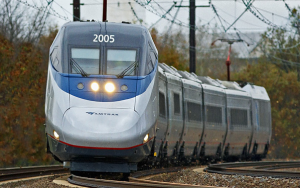By Dennis Powell, e-Management

Did you know a trip by Amtrak results in less greenhouse gas emissions than other popular modes of travel? (Photo: Amtrak)
The National Railroad Passenger Corporation, known as Amtrak, is a quasi-government organization that officially launched 44 years ago. Amtrak provides passenger train service to nearly 31 million passengers to towns and cities across the country. Since 1971, Amtrak has relied on federal money—much to the chagrin of some members of Congress, which authorizes the passenger railroad service’s funding. Amtrak has also faced significant challenges. The Federal Railroad Administration (FRA) data shows that between 2010 and 2014, there has been an average of 26 derailments annually. So far, this year there has been at least nine. Amtrak’s May 12th derailment in Philadelphia left over a half dozen dead and more than 140 injured. The accident renewed criticism around the organization’s safety and funding. Others have criticized the passenger rail service for what they see as old-fashioned technology, which lags behind the United Kingdom, France, Japan, and China.
Enough of the criticism!
With all the negative press and unfortunate events around Amtrak over the past few weeks, it’s sometimes too hard to remember that there are benefits and conveniences to using the rail service. We’ve pulled together a list of why Amtrak is important to life in America.
- Amtrak drops passengers and business travelers off in the actual city they are visiting. First time visitors to Washington, DC—a popular Amtrak destination—are usually surprised at the hurdles they may have to go through to get from Dulles International Airport to the city, which is located about 27 miles away (up to an hour of driving if there is traffic). In contrast, Amtrak passengers are dropped off at Union Station, only a few blocks from Congress, eateries, hotels, historical sites, and downtown DC. The same is true for rail stations in New York City, Philadelphia, and other towns serviced by Amtrak. Say goodbye to those $75 taxi rides to the hotel and those sometimes frustrating multiple stops via shuttle service providers!
- Amtrak’s travel experience is often less of a hassle…Passengers get more leg room than the typical premium, extra cost seats on airlines AND they don’t have to pay extra! Plus, travelers won’t be stuck in the dreaded middle seat because there aren’t any on Amtrak. Customers can power up their smartphones, tablets, or laptops using power outlets on trains. There is also free Wi-Fi on some trains. What about those popular $50 luggage fees and other hidden costs associated with some airlines? Well, the Amtrak website states there are “no extra fees—what you see is what you get.” Perhaps best of all, passengers aren’t required to show up two hours before the train leaves, wait in long security lines, or undress (removing shoes, belts, etc.) before jumping abroad. For city to city/regional travel, Amtrak seems like a more streamlined approach to traveling.
- Traveling by Amtrak is greener than air travel or a road trip. That’s right. A trip by rail results in less greenhouse gas emissions than other popular modes of travel! The U.S. Department of Energy Oak Ridge National Laboratory Data on Fuel Efficiency – Transportation Energy Data Book (Edition 33) illustrates that traveling by rail is 30% more efficient (in terms of mileage) than by auto. Amtrak is so committed to reducing its passengers’ carbon footprint, it has partnered with Carbonfund.org. This partnership empowers Amtrak riders to offset their “carbon emissions footprint” through making voluntary contributions to Carbonfund.org—a nonprofit dedicated to reducing the environmental impact of energy consumption. Find out more at
- Amtrak puts Americans to work. The rail service employs more than 20,000 people. As one might expect, Amtrak staff and loved ones can take advantage of complimentary services on the rail systems traveling throughout its 21,300-mile (34,000 km) system. Amtrak employees don’t pay Social Security taxes. Instead, they get a higher retirement benefit by paying special taxes as a result of the Railroad Retirement Tax Act (RRTA). Plus, they can elect to participate in a traditional 401(k) retirement plan.
Not Even Close to Perfect
Amtrak isn’t the most advanced passenger rail system in the world. Its federal funding will likely be cut again in the next fiscal year. And yes, it has yet to turn a profit. Still, with proper guidance, investments, and upgrades to its infrastructure, Amtrak’s future days could be brighter. (1) What are your thoughts of rail vs. road vs. air travel? (2) Do you think Amtrak is good for America? (3) When was the last time you traveled by rail (excluding light rail and subway systems)?



